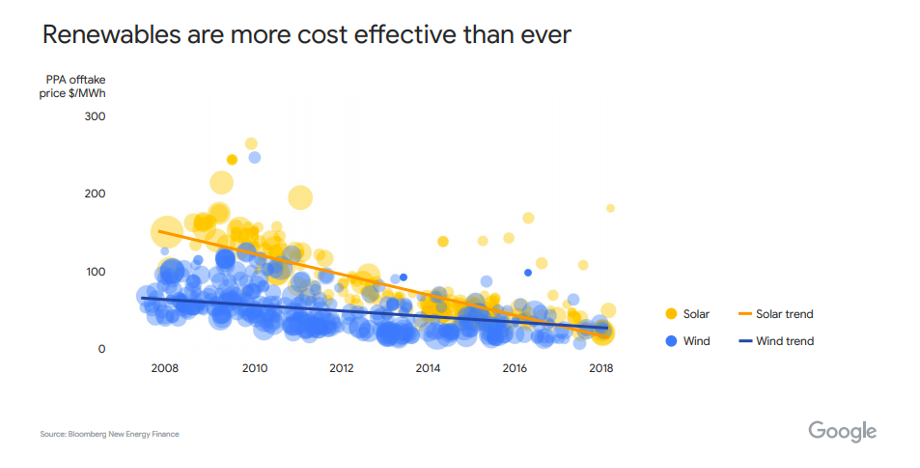

Looking to the Future: The Role Technology Will Play in Helping Corporates Meet their Clean Energy Goals
Medium Monday, June 29th 2020Google drives clean energy transition on a global scale. In 2012, Google committed to 100 percent clean energy and since 2017, it has achieved that goal by using renewables to meet its energy needs. Looking ahead, the tech company aims to consume clean energy 24×7 and is looking to work with cleantechs offering innovative and scalable solutions. At the Dynamo Energy Hub’s virtual event on June 3, 2020, Google’sHead of Energy Strategy, Global Infrastructure, Neha Palmer, and Google’s Carbon Free Energy Lead, Maud Texier, outlined how Google is pushing the decarbonization envelope and advancing clean energy innovation worldwide.
Getting to 100 Percent Renewable Energy
In 2012, Google committed to 100 percent clean energy, when electricity prices for wind and solar were much higher and the technologies not as developed. Eight years ago, corporate purchasing of utility-scale renewable energy was still a novel concept, however; a lot has changed and Google paved the way for many corporations to reduce their carbon footprint (see the chart below). Today, Google is the world’s largest corporate purchaser of renewable electricity with 5.97 GW of energy currently under contract.

Renewable Energy is Now More Cost-Effective than Ever
For large corporations like Google, cost-efficiency is key. Until 2016, Google prioritized wind in its power purchase agreements (PPAs) due to its favorable costs and availability. However, in recent years, the solar and wind cost trajectories have converged, thanks to the steep decline in the cost of solar panels. As the result, in 2019, solar received the bulk of Google’s engagement.

“When we think of technology, we definitely want to be engaging with the cutting-edge [technology developers] but being able to see that the cost curves come down overtime certainly helps corporates adopt technology,” said Neha Palmer.
Google’s large energy needs even allowed it to organize utility-style auctions across multiple markets in 2019, in which renewable electricity-producers bid for long-term contracts with the company. These auctions were hugely successful and allowed Google to purchase more renewable energy than any of the previous years. All in all, Google signed contracts for more than 1.8 GW of renewable energy. This corresponds to more than 740 large wind turbines or 5.6 million solar panels.

The company also sees its commitment to clean energy, coupled with the scale of its investment, as helping to drive the clean energy transition, which is particularly critical in light of COVID-induced economic slowdown.
“Our purchase of more than 5 GW [of renewable energy in 2019] has effectuated $7 billion of investments into renewable power projects across the globe,” said Neha Palmer.
Carbon-Free Electricity Everywhere, at All Times
While Google matches all of its energy needs with renewable energy through PPAs, it is still impossible to power all of their data centers around the world with zero fossil fuel-generated electrons. As the servers need energy at all times, including when the wind doesn’t blow and sun doesn’t shine, Google buys a surplus of renewable energy in regions or hours when renewable power is abundant.
But, as the panelists explained, Google wants to do more and aspires for 24×7 renewable energy.
“Our goal is not just to achieve 24×7 access to carbon-free energy as soon as possible. We want to pave the way for deep grid decarbonization…also for other corporates and businesses,” said Maud Texier.

Advancing Innovation
Google is open to working with innovative energy startups, and is interested in those that push the envelope in the industry when it comes to decarbonization. A cleantech’s ability to scale and deliver at least 5–10 MW of clean energy is crucial to be considered for a pilot by the company.
“We have a unique ability given our scale and global reach to do some interesting pilots,” said Neha Palmer.
Due to the consistent nature of its data centers’ energy consumption, Google is interested in innovative technologies that can provide stable baseload power. Ms. Texier, for example, sees great potential for geothermal power in Asia. But the company also is open for more early-stage technologies.
“We see a lot of potential for wind and solar. But we also recognize that we are going to need more than that to really procure 70 or 80 or even 90 percent of [carbon-free energy] for certain regions,” she said.
In closing, both speakers emphasized the need for accessible and efficient energy consumption data, which should be provided to energy consumers. Only if companies understand what type of energy they consume will they be able to ever achieve the 24×7 carbon-free electricity.
For media relations contact
Claudia Prandoni Marketing & Communications Manager